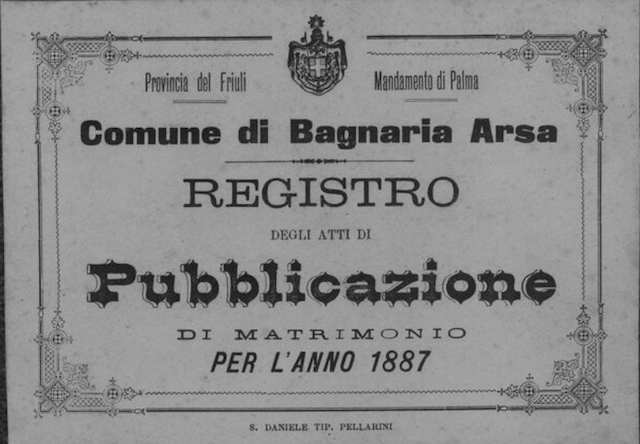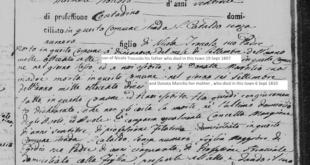Last month, I explained how our ancestors married people from their town of birth a large percentage of the time. This was a byproduct of transportation difficulties, and the custom of arranged marriages, among other reasons.
So before entering the once-indissoluble state of Holy Matrimony, a series of documents were assembled to verify that the marriage would be legitimate and could not be challenged. One type of document was the marriage banns, known in Italy as the pubblicazioni. These were used to tell the town that these two people wanted to marry (or their parents wanted them to marry), and inviting anyone with reason to object to speak now or forever hold their peace.
I remember when I was a kid, I would read the church bulletin (I should have paid more attention to the Mass….) and there would be a short section mentioning first or second banns, and the names of couples, and then the next week, the second banns couples disappeared from the list. So the parish community of St. Louis de Montfort in Oak Lawn would have the chance to step in and object to the marriage. I would have to presume that very few people did.
In the Italian records, the pubblicazioni look a lot like the Matrimoni records. They contain the names of the groom and bride, their ages and birthplaces, names of each of their parents and whether each parent is living or deceased at the time of the banns. They contain basically the same data as the marriages. So why do we need the pubblicazioni at all? Three reasons. Reason 1: you are not sure where your ancestor got married. You can check the banns in their town of birth to see if they show the town where the marriage was to take place. Reason 2: You are curious to see if your ancestor was engaged to someone that they never married. I’m not sure you will find the reason for the lack-of-marriage, but you would at least find out that they were almost married until someone objected. Reason 3: This is the most useful one. If the marriages for a particular year are missing or unreadable, you can use the banns as a substitute to get the info you need about their parents.
While the banns took their normal course, officials gathered a bunch of other documents that could effectively prevent the marriage if there was a problem. This file full of documents is called the “allegati” and they are incredibly helpful for our research.
The objective was not to block the marriage, but they wanted to make sure that there would be no problem that would surface after the marriage took place.
Question #1: Who are the bride and groom and who are their parents?
This is a simple matter of finding and copying the birth records of both of them. Sometimes, the town clerk would write on the birth record an annotation when that person got married. So if that person applied to marry again, it would be easy to retrieve the first marriage record.
Question #2: Are the groom or bride already married?
Yeah, that’s a thorny one. Most spouses don’t like to wake up to find that their husband or wife is already married to someone else! This was an era of people dying of childbirth or tuberculosis or cholera in young adulthood. When this happened, it was essential that the surviving spouse remarried, and usually very quickly. If the husband died young, the widow and children needed a means of support. If the wife died young, the husband needed a new wife to take care of the kids. So when the surviving spouse would apply to remarry, I’m sure they would typically explain that they had married before and that their previous spouse died on such-and-such date in such-and-such town. The town clerk would go through the death records and retrieve the death of the prior spouse. They would have to copy the death record (an “estratto”) for use in the allegati.
Question #3: Does the father of the bride approve of the marriage?
I’m not sure what the laws were. I presume that after a certain age, a girl could marry without her father’s consent. The allegati that I have worked with does not have a permission paper on file for every marriage. But in some circumstances, the father of the bride was in America when his daughter was engaged to wed. I have seen many times where there is a paper from a notary in Chicago, for example, translated to Italian, where the father of the bride is giving his permission for her to marry.
Question #4: The father of the groom or bride is already deceased. He cannot consent to the marriage.
If the father of either the groom or bride had died prior to the marriage of their child, an estratto copy of the death record of the father would be added to the allegati. Most often the death of the father of the bride was included. If the groom was of age, nobody included his father’s death record in the allegati. Deaths of the mothers of the groom or bride are rarely included in the allegati. However, the best part of this for our research is that we get the date and town of the death of that parent, even if they died in another town, province, or even America. I could not find the death of Antonio Abbinante in Carbonara who was the father of my step-great-grandfather Palmo. I also could not find the death of Carlo Liturri, my great-grandfather who died when he arrived at Ellis Island. When I found the allegati, I found a translated copy of my great-grandfather’s death in Kings County New York (which would answer question 2) and a copy of the death of Antonio in 1901 in Foggia.
Question #5: How can they marry if there is no dowry?
My ancestors were almost always peasant farmers (contadini) so they didn’t have a lot of money. And so, a frequent document found in allegati is the “certificata di povera.”
So how do we find these wonderful records? They are in the catalog, just like the regular births, deaths etc. There may be allegati di morte also, but you need to look for allegati di matrimony, or just “allegati” with no qualifier. These records are grouped by the year of marriage, but are otherwise not in any particular order. Each allegati file has a title page that shows the Groom and Bride’s names, followed by all the records for that marriage, followed by another title page. These title pages and accompanying papers are grouped sometimes alphabetically by the groom’s surname, sometimes in the same order as the marriages took place, and sometimes completely random. They are NOT easy to navigate. Once you determine which order they are in, you can jump forward or backward to skip to hopefully the correct couple. Do not be surprised if you’re in the correct year and town and you do not find your couple. It doesn’t mean that they had no allegati file. It means that the files were such a mess that they weren’t filmed completely.
I believe that during the period leading up to the marriage, the allegati file would be used a lot, and after the marriage, it might be used very infrequently by the town clerk. So it is not a surprise that the allegati records are incomplete. It wasn’t a high-priority item for the clerk.
What years are available? Good question. Glad you asked! I am most familiar with Bari and those start around 1862 (they were called Processetti 1862-1865). I also know that a lot of towns in Sicily have allegati going all the way back to 1820. This is great because you can get estratto of baptism records before civil records started in Sicily in 1820, and estratto of the deaths of their parents that occurred before 1820. You will have to check your town to see what it has. If your town has no allegati, look under the province. Also, note the item number in the catalog so you can skip to item #9 and not have to read image-by-image a bunch of allegati records from the wrong town.
As always, if you have a question, please send me an e-mail to italianroots@comcast.net and please put “Fra Noi” in the subject. Happy hunting!
 Fra Noi Embrace Your Inner Italian
Fra Noi Embrace Your Inner Italian







